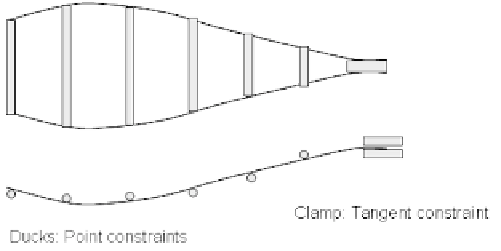Graphics Reference
In-Depth Information
Fig. 9.1.
Wooden splines for boat building.
held in London in 1987. They introduced the concept of snakes by stating
that,“A snake is an energy minimizing spline guided by external contraint
forces and influenced by image forces that pull it towards lines and edges.”
Unlike Bernstein-Bezier splines, the splines of Kass et al. could determine their
own control points directly from the image under analysis by using constraints
based on image intensity and gradient. This was an exciting time in computer
vision research and represented a major break from image analysis via the
sequential linking of low level features such as edges and intensities.
Kass, Witken, and Terzopoulos were working for Schlumberger Palo-Alto
Research and were interested in using snakes to speed up the manual labeling
of seismic data as required for oil exploration. These seismic images are com-
plicated and their interpretation requires the input of interpretation experts.
Indeed, sometimes there would be little agreement between the experts. In
the words of Kass et al. [88]:
Different seismic interpreters can derive significantly different percep-
tual organizations from the same seismic sections depending on their
knowledge and training. Because a single “correct” interpretation can-
not always be defined, we suggest low-level mechanisms which seek
appropriate local minima instead of searching for global minima.
Thus the authors saw snakes as an interactive “power assist” for manual
labeling by a human expert rather than as a fully automatic image interpreter
algorithm in its own right. The human expert would adjust the snake by hand
until it was close to the desired solution, and the snake energy minimization
would do the rest.
In the case of seismic sections, the effort of manually labeling the images
is relatively low compared to the huge expense and effort of collection. How-
ever, in the case of, say, computer analysis of closed circuit television feeds
for building security, the process of image analysis must be completely auto-
matic and reliable to be effective. Fortunately, in many image labeling tasks,
interpretation is much more straightforward than for seismic sections. Indeed,
in many cases, virtually all people would agree on the same interpretation.

Search WWH ::

Custom Search